
London Trams, previously Tramlink and Croydon Tramlink, is a light rail tram system serving Croydon and surrounding areas in South London, England. It began operation in 2000, the first tram system in London since 1952. It is owned by London Trams, part of Transport for London (TfL), and has been operated by FirstGroup since 2017. Tramlink is one of two light rail networks in Greater London, the other being the Docklands Light Railway.

The Docklands Light Railway (DLR) is an automated light metro system serving the redeveloped Docklands area of London, England. First opened on 31 August 1987, the DLR has been extended multiple times, giving a total route length of 38 km (24 mi). Lines now reach north to Stratford, south to Lewisham, west to Tower Gateway and Bank in the City of London financial district, and east to Beckton, London City Airport and Woolwich Arsenal. Further extensions are under consideration.

The London Underground is a rapid transit system serving Greater London and some parts of the adjacent counties of Buckinghamshire, Essex and Hertfordshire in the United Kingdom.

The Tube map is a schematic transport map of the lines, stations and services of the London Underground, known colloquially as "the Tube", hence the map's name. The first schematic Tube map was designed by Harry Beck in 1931. Since then, it has been expanded to include more of London's public transport systems, including the Docklands Light Railway, London Overground, TfL Rail, Tramlink, the Emirates Air Line cable car and Thameslink.

Transport for London (TfL) is a local government body responsible for most of the transport network in London, England.
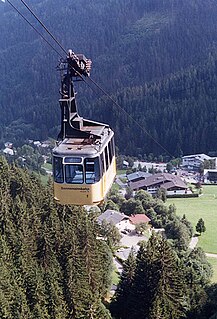
Cable transport is a broad class of transport modes that have cables. They transport passengers and goods, often in vehicles called cable cars. The cable may be driven or passive, and items may be moved by pulling, sliding, sailing, or by drives within the object being moved on cableways. The use of pulleys and balancing of loads moving up and down are common elements of cable transport. They are often used in mountainous areas where cable haulage can overcome large differences in elevation.

Crossrail is a railway construction project under way mainly in central London. Its aim is to provide a high-frequency suburban passenger service crossing the capital from west to east, by connecting two major railway lines terminating in London, the Great Western Main Line and the Great Eastern Main Line. The project was approved in 2007, and construction began in 2009 on the central section and connections to existing lines that will become part of the route, to be branded the Elizabeth line in honour of Queen Elizabeth II.

A gondola lift is a means of cable transport and type of aerial lift which is supported and propelled by cables from above. It consists of a loop of steel wire rope that is strung between two stations, sometimes over intermediate supporting towers. The cable is driven by a bullwheel in a terminal, which is typically connected to an engine or electric motor. It is often considered a continuous system since it features a haul rope which continuously moves and circulates around two terminal stations. In contrast, an aerial tramway operates solely with fixed grips and simply shuttles back and forth between two end terminals.

North Greenwich is a London Underground station served by the Jubilee line. Despite its name, it is not in the local area historically known as North Greenwich, on the Isle of Dogs, north of the River Thames; a completely different North Greenwich station used to be there, from 1872 until 1926. It is actually closer to Charlton than to Greenwich; however, it is at the northernmost tip of the Royal Borough of Greenwich, which perhaps gives the best explanation of the name.

The Woolwich Ferry is a free vehicle and pedestrian ferry across the River Thames in East London, connecting Woolwich on the south bank with North Woolwich on the north. It is licensed and financed by London River Services, the maritime arm of Transport for London (TfL). Around two million passengers use the ferry each year.

London River Services Limited is a division of Transport for London (TfL), which manages passenger transport—leisure-oriented tourist services and commuter services—on the River Thames in London. It does not own or operate any boats itself, but licenses the services of operators.
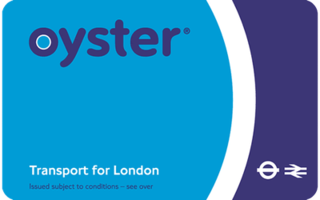
The Oyster card is a payment method for public transport in London in the United Kingdom. A standard Oyster card is a blue credit-card-sized stored-value contactless smart card. It is promoted by Transport for London (TfL) and can be used on travel modes across London including London Buses, London Underground, the Docklands Light Railway (DLR), London Overground, Tramlink, some river boat services, and most National Rail services within the London fare zones. Since its introduction in June 2003, more than 86 million cards have been used.

Thames Clippers is a river bus service on the Thames in London, England.
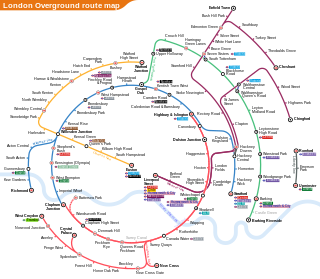
Orbirail was a name for a suggested orbital railway route around London.

London has an extensive and developed transport network which includes both private and public services. Journeys made by public transport systems account for 37% of London's journeys while private services accounted for 36% of journeys, walking 24% and cycling 2%. London's public transport network serves as the central hub for the United Kingdom in rail, air and road transport.
The Roads and Transport Authority (RTA) was formed by the decree number 17 for the year 2005.

Public transport is a system of transport for passengers by group travel systems available for use by the general public unlike private transport, typically managed on a schedule, operated on established routes, and that charge a posted fee for each trip. There is no rigid definition; the Encyclopædia Britannica specifies that public transportation is within urban areas, and air travel is often not thought of when discussing public transport—dictionaries use wording like "buses, trains, etc." Examples of public transport include city buses, trolleybuses, trams and passenger trains, rapid transit and ferries. Public transport between cities is dominated by airlines, coaches, and intercity rail. High-speed rail networks are being developed in many parts of the world.
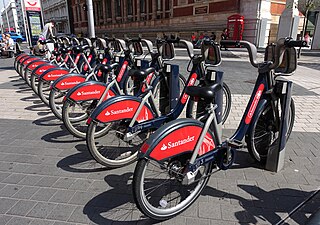
Santander Cycles is a public bicycle hire scheme in London in the United Kingdom. The scheme's bicycles are popularly known as Boris Bikes, after Boris Johnson who was Mayor of London when the scheme began operating.

The Eyüp Gondola, a.k.a. Eyüp–Piyerloti Aerial Cable Car, is a two-station gondola-type line of aerial lift passenger transport system located in Eyüp district of Istanbul, Turkey. Opened on November 30, 2005, the 384 m (1,260 ft) long line serves the Piyerloti Hill from Eyüp at the coast of Golden Horn. It is operated under the line number Tf2 by Istanbul Transport Company, a subsidiary of Istanbul Metropolitan Municipality. The fare is paid by the contactless smart card of Istanbulkart, which is valid at all public transport in Istanbul.
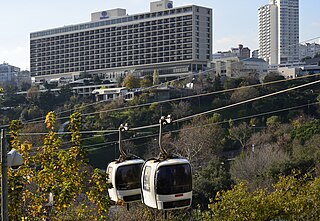
The Maçka Gondola, aka Maçka – Taşkışla Aerial Cable Car, is a two-station gondola-type line of aerial lift passenger transport system situated in Şişli district of Istanbul, Turkey. Opened on April 11, 1993, the 333.5 m (1,094 ft) long line connects Maçka neighborhood with Taşkışla quarter close to Taksim Square. It is operated under the line number Tf1 by Istanbul Transport Company, a subsidiary of Istanbul Metropolitan Municipality. The fare is paid by the contactless smart card of Istanbulkart, which is valid at all public transport in Istanbul.

























